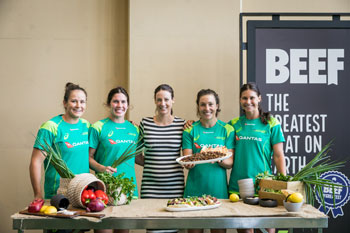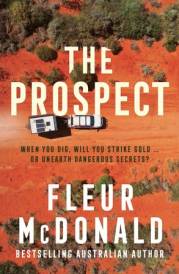Peta Carige Australian Women's Rugby 7s Dietician Interview

Cook Like The Australian Women's Rugby 7s With Their Favourite Beef Recipes
Try these delicious and easy recipes made with the Greatest Meat on Earth that can help athletes and everyday Aussies perform at their best.
Have you ever wondered what it takes to be one of the greatest gold-medal winning athletes? From tough training, to eating right, there's more to it than just what happens on the field.
Dietitian to the Australian Women's Rugby 7s team, Peta Carige, has shared four of the ultimate beef recipes that she recommends and prepares for the players as part of their nutritious weekly meal plans. The recipes include a favourite of players Charlotte Caslick, Demi Hayes, Shannon Parry, and Emilee Cherry – -Spiced Beef and Hummus', that you can now try at home.
Australian Beef is an excellent protein source of iron, with dietitians recommending 130g of cooked lean red meat to be enjoyed every other day as a practical way for busy athletes and any busy woman to get the nutrients they need to perform at their best.
With a variety of cuts available, beef offers multiple ways to create diverse, healthy and balanced meals for everyone – from elite athletes to everyday Aussies. Nothing beats Australian Beef when it comes to taste, quality, and nutrition!
 Interview with Peta Carige, Australian Women's Rugby 7s Dietician
Interview with Peta Carige, Australian Women's Rugby 7s Dietician
Question: What is the average day on a plate for a Women's Rugby 7's player?
Peta Carige: It does change a lot based on their training schedule, but often the girls will eat breakfast at home, have a snack pre-training, lunch provided on-site by our catering chef, post-gym protein and then a snack on way home or at home before a healthy dinner.
Question: How important is diet in fuelling the players for success on the field?
Peta Carige: It is hugely important (I am bias). This was recognised in the lead up to Rio when my position was appointed just under 2 years out from the Olympics. It has a major role in 7's specifically because of the intensity of the games and also the tournament format of 3 games per day. The girls often have very short breaks in-between, which makes recovery nutrition imperative.
Question: How do you help the players prepare for a big competition – do you make any changes to their diets?
Peta Carige: Yes, in the lead up to major competitions like Rio or Comm Games or recently Sydney, the S&C and I set physical targets for the girls to hit, therefore I usually have to -tighten up' their diets in the lead up and I often do this through food diaries and meal plans.
Question: What role do you play in educating the team with nutrition and cooking? What do you find are the biggest challenges and how do you overcome them?
Peta Carige: I would say a lot, however, most of my education occurred early on in the program and now I do more one on ones as new athletes enter the program. I also do cooking classes with every new athlete that enters the program, as having the skills to eat healthy food is pivotal for athletes. My education, now that a lot of the girls are a bit more senior, is more about specific nutrition facts / ergogenic aids or any tournament interventions we might be trialing.
Question: What role does beef play in the players' diets and why is it important (e.g. nutritional benefits, iron, etc.)?
Peta Carige: Beef plays a huge role in the girls' diets, because they have significantly higher than average iron requirements; we partially suspect this is due to the contact component of their game but also due to their training loads and being female. The other important nutrient role that beef plays is providing protein for recovery from their training and also zinc for their immunity.
Question: What tips can the average Aussie take from Women's Rugby 7's team diet?
Peta Carige: I think consistency. I've drilled into the girls that as females we can't have two good weeks then two bad weeks with our diets and I've really encouraged that their beef intake is consistent at a minimum of 4 times per week so it becomes habitual and they don't need to think about it too often.
 Question: How can everyday Aussies incorporate beef into their diet (e.g. benefits and how much to eat)?
Question: How can everyday Aussies incorporate beef into their diet (e.g. benefits and how much to eat)? Peta Carige: I think the best thing about beef is that it can be included in so many recipes for summer or winter. As far as nutrition, a positive about beef is that it includes nutrients that can literally make you feel better, if you include it frequently. In our time-poor society so many beef recipes make great leftovers; spag bol, chili con carne, beef stroganoff in winter or a beef casseroles, they all make such tasty leftovers and can easily be prepared ahead and frozen. This is really important for every day Aussies these days, as healthy food options are the first thing to drop off when we are busy.
Question: What are your favourite beef recipes to recommend to the players?
Peta Carige: Beef hummus entrée has been the absolute favourite dish in cooking classes consistently the past year and it is a favourite of mine for a Friday night Footy dinner. I always recommend quick BBQ steak meal ideas, so BBQ'd beef with side of zucchini, mushrooms and corn all done on the BBQ so it is really quick and simple prep for the athletes. In winter I recommend a beef mince mixed with quinoa and stuffed in capsicums, it's a bit of a made up recipe, but the girls love it.
Question: What is your personal favourite beef recipe?
Peta Carige: My personal favourite is a fresh steak on the farm cooked over a fire and I always do a big salad usually with couscous or quinoa to go on the side filled with veggies, craisens, nuts, feta. Come winter, I can't go past a beef stroganoff.
 Spiced Beef with Hummus
Spiced Beef with Hummus
Spice up your day with this delicious meal with a Middle Eastern flare.
Prep Time: 15 minutes
Cooking Time: 10 minutes
Serves: 4
Ingredients
400g lean beef mince
2 x 400g can chickpeas, rinsed, drained
½ cup tahini
½ cup lemon juice
2 garlic cloves, crushed
½ large capsicum, diced
1 red onion, diced
1 garlic cloves
2 tsp ground allspice
1 tsp ground cinnamon
2 tsp pomegranate molasses
Pomegranate seeds (craisins are an alternative)
Parsley
Pita or Lebanese bread, warmed and ready to serve
Method
To make hummus, place chickpeas, tahini, lemon juice and 150ml oil and 2 garlic cloves into a food processor and process until combined. Add 60ml warm water and process until smooth. Season with salt and pepper. Set aside.
Place mince in a bowl and mix in oil. Heat a large frypan until hot. Crumble in half of the mince. Brown the mince, breaking up any lumps with a fork. Remove first batch, reheat pan and cook remaining mince.
Stir in spices and vegetables and continue to cook for a further 2 minutes.
Stir in pomegranate molasse and season
Allow it to cool slightly, then spoon beef mixture over the hummus.
Scatter with pomegranate (craisins), parsley and serve with heated pita bread cut into triangles.
Essential Tips: As the mince cooks, break up lumps with a fork. Let the first side of the mince sear lightly before using a fork to break up the larger pieces. As it cooks, tilt the pan slightly and spoon away the liquid – this helps brown the mince.
MORE



